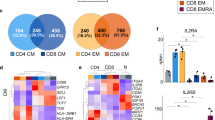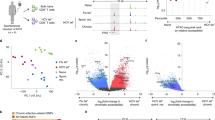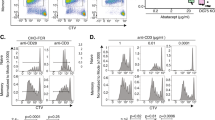Abstract
The epigenetic determinants driving the responses of CD4 T cells to antigen are currently an area of active research. Much has been done to characterize helper T-cell subsets and their associated genome-wide epigenetic patterns. In contrast, little is known about the dynamics of histone modifications during CD4 T-cell activation and the differential kinetics of these epigenetic marks between naive and memory T cells. In this study, we have detailed the dynamics of genome-wide promoter H3K4me2 and H3K4me3 over a time course during activation of human naive and memory CD4 T cells. Our results demonstrate that changes to H3K4 methylation occur relatively late after activation (5 days) and reinforce activation-induced upregulation of gene expression, affecting multiple pathways important to T-cell activation, differentiation and function. The dynamics and mapped pathways of H3K4 methylation are distinctly different in memory cells, which have substantially more promoters marked by H3K4me3 alone, reinforcing their more differentiated state. Our study provides the first data examining genome-wide histone modification dynamics during CD4 T-cell activation, providing insight into the cross talk between H3K4 methylation and gene expression, and underscoring the impact of these marks upon key pathways integral to CD4 T-cell activation and function.
This is a preview of subscription content, access via your institution
Access options
Subscribe to this journal
Receive 6 digital issues and online access to articles
$119.00 per year
only $19.83 per issue
Buy this article
- Purchase on Springer Link
- Instant access to full article PDF
Prices may be subject to local taxes which are calculated during checkout








Similar content being viewed by others
References
McKinstry KK, Strutt TM, Swain SL . The potential of CD4 T-cell memory. Immunology 2010; 130: 1–9.
Rothbart SB, Strahl BD . Interpreting the language of histone and DNA modifications. Biochim Biophys Acta 2014; 1839: 627–643.
Zhou VW, Goren A, Bernstein BE . Charting histone modifications and the functional organization of mammalian genomes. Nat Rev Genet 2011; 12: 7–18.
Lessard JA, Crabtree GR . Chromatin regulatory mechanisms in pluripotency. Annu Rev Cell Dev Biol 2010; 26: 503–532.
Tee WW, Reinberg D . Chromatin features and the epigenetic regulation of pluripotency states in ESCs. Development 2014; 141: 2376–2390.
Vastenhouw NL, Schier AF . Bivalent histone modifications in early embryogenesis. Curr Opin Cell Biol 2012; 24: 374–386.
Neff T, Armstrong SA . Chromatin maps, histone modifications and leukemia. Leukemia 2009; 23: 1243–1251.
Burney MJ, Johnston C, Wong KY, Teng SW, Beglopoulos V, Stanton LW et al. An epigenetic signature of developmental potential in neural stem cells and early neurons. Stem Cells 2013; 31: 1868–1880.
Barski A, Cuddapah S, Cui K, Roh TY, Schones DE, Wang Z et al. High-resolution profiling of histone methylations in the human genome. Cell 2007; 129: 823–837.
Wei G, Wei L, Zhu J, Zang C, Hu-Li J, Yao Z et al. Global mapping of H3K4me3 and H3K27me3 reveals specificity and plasticity in lineage fate determination of differentiating CD4+ T cells. Immunity 2009; 30: 155–167.
Russ BE, Olshanksy M, Smallwood HS, Li J, Denton AE, Prier JE et al. Distinct epigenetic signatures delineate transcriptional programs during virus-specific CD8(+) T cell differentiation. Immunity 2014; 41: 853–865.
Santos-Rosa H, Schneider R, Bannister AJ, Sherriff J, Bernstein BE, Emre NC et al. Active genes are tri-methylated at K4 of histone H3. Nature 2002; 419: 407–411.
Gu B, Lee MG . Histone H3 lysine 4 methyltransferases and demethylases in self-renewal and differentiation of stem cells. Cell Biosci 2013; 3: 39.
Wozniak GG, Strahl BD . Hitting the 'mark': interpreting lysine methylation in the context of active transcription. Biochim Biophys Acta 2014; 1839: 1353–1361.
Clouaire T, Webb S, Skene P, Illingworth R, Kerr A, Andrews R et al. Cfp1 integrates both CpG content and gene activity for accurate H3K4me3 deposition in embryonic stem cells. Genes Dev 2012; 26: 1714–1728.
Vermeulen M, Mulder KW, Denissov S, Pijnappel WW, van Schaik FM, Varier RA et al. Selective anchoring of TFIID to nucleosomes by trimethylation of histone H3 lysine 4. Cell 2007; 131: 58–69.
van Nuland R, Schram AW, van Schaik FM, Jansen PW, Vermeulen M, Marc Timmers HT . Multivalent engagement of TFIID to nucleosomes. PLoS One 2013; 8: e73495.
Orford K, Kharchenko P, Lai W, Dao MC, Worhunsky DJ, Ferro A et al. Differential H3K4 methylation identifies developmentally poised hematopoietic genes. Dev Cell 2008; 14: 798–809.
Wang Z, Zang C, Rosenfeld JA, Schones DE, Barski A, Cuddapah S et al. Combinatorial patterns of histone acetylations and methylations in the human genome. Nat Genet 2008; 40: 897–903.
Zhang JA, Mortazavi A, Williams BA, Wold BJ, Rothenberg EV . Dynamic transformations of genome-wide epigenetic marking and transcriptional control establish T cell identity. Cell 2012; 149: 467–482.
Lim PS, Hardy K, Bunting KL, Ma L, Peng K, Chen X et al. Defining the chromatin signature of inducible genes in T cells. Genome Biol 2009; 10: R107.
Barski A, Jothi R, Cuddapah S, Cui K, Roh TY, Schones DE et al. Chromatin poises miRNA- and protein-coding genes for expression. Genome Res 2009; 19: 1742–1751.
Allan RS, Zueva E, Cammas F, Schreiber HA, Masson V, Belz GT et al. An epigenetic silencing pathway controlling T helper 2 cell lineage commitment. Nature 2012; 487: 249–253.
Gower JC . Some distance properties of latent root and vector methods used in multivariate analysis. Biometrika 1966; 53: 325–338.
Li Y, Chen G, Ma L, Ohms SJ, Sun C, Shannon MF et al. Plasticity of DNA methylation in mouse T cell activation and differentiation. BMC Mol Biol 2012; 13: 16.
Lee CG, Hwang W, Maeng KE, Kwon HK, So JS, Sahoo A et al. IRF4 regulates IL-10 gene expression in CD4(+) T cells through differential nuclear translocation. Cell Immunol 2011; 268: 97–104.
Staal FJ, Luis TC, Tiemessen MM . WNT signalling in the immune system: WNT is spreading its wings. Nat Rev Immunol 2008; 8: 581–593.
Turner MD, Nedjai B, Hurst T, Pennington DJ . Cytokines and chemokines: At the crossroads of cell signalling and inflammatory disease. Biochim Biophys Acta 2014; 1843: 2563–2582.
Mikkelsen TS, Ku M, Jaffe DB, Issac B, Lieberman E, Giannoukos G et al. Genome-wide maps of chromatin state in pluripotent and lineage-committed cells. Nature 2007; 448: 553–560.
Kimura H . Histone modifications for human epigenome analysis. J Hum Genet 2013; 58: 439–445.
Soler D, Chapman TR, Poisson LR, Wang L, Cote-Sierra J, Ryan M et al. CCR8 expression identifies CD4 memory T cells enriched for FOXP3+ regulatory and Th2 effector lymphocytes. J Immunol 2006; 177: 6940–6951.
Meng H, Cao Y, Qin J, Song X, Zhang Q, Shi Y et al. DNA methylation, its mediators and genome integrity. Int J Biol Sci 2015; 11: 604–617.
Guo H, Zhu P, Yan L, Li R, Hu B, Lian Y et al. The DNA methylation landscape of human early embryos. Nature 2014; 511: 606–610.
Pan G, Tian S, Nie J, Yang C, Ruotti V, Wei H et al. Whole-genome analysis of histone H3 lysine 4 and lysine 27 methylation in human embryonic stem cells. Cell Stem Cell 2007; 1: 299–312.
Zhao XD, Han X, Chew JL, Liu J, Chiu KP, Choo A et al. Whole-genome mapping of histone H3 Lys4 and 27 trimethylations reveals distinct genomic compartments in human embryonic stem cells. Cell Stem Cell 2007; 1: 286–298.
Pekowska A, Benoukraf T, Ferrier P, Spicuglia S . A unique H3K4me2 profile marks tissue-specific gene regulation. Genome Res 2010; 20: 1493–1502.
Young MD, Willson TA, Wakefield MJ, Trounson E, Hilton DJ, Blewitt ME et al. ChIP-seq analysis reveals distinct H3K27me3 profiles that correlate with transcriptional activity. Nucleic Acids Res 2011; 39: 7415–7427.
Chakraborty AK, Weiss A . Insights into the initiation of TCR signaling. Nat Immunol 2014; 15: 798–807.
Wang Y, Li X, Hu H . H3K4me2 reliably defines transcription factor binding regions in different cells. Genomics 2014; 103: 222–228.
Rotem A, Ram O, Shoresh N, Sperling RA, Goren A, Weitz DA et al. Single-cell ChIP-seq reveals cell subpopulations defined by chromatin state. Nat Biotechnol 2015; 33: 1165–1172.
Kundaje A, Meuleman W, Ernst J, Bilenky M, Yen A, Heravi-Moussavi A et alRoadmap Epigenomics Consortium. Integrative analysis of 111 reference human epigenomes. Nature 2015; 518: 317–330.
Das S, Das P, Mitra S, Dasgupta M, Chakrabarti J, Larsson E . Epigenetic transfiguration of H3K4me2 to H3K4me3 during differentiation of embryonic stem cell into non-embyronic cells. RNA and Transcription 2015; 1: 18–33.
Gerondakis S, Banerjee A, Grigoriadis G, Vasanthakumar A, Gugasyan R, Sidwell T et al. NF-kappaB subunit specificity in hemopoiesis. Immunol Rev 2012; 246: 272–285.
Komori HK, Hart T, LaMere SA, Chew PV, Salomon DR . Defining CD4 T cell memory by the epigenetic landscape of CpG DNA methylation. J Immunol 2015; 194: 1565–1579.
Hashimoto H, Vertino PM, Cheng X . Molecular coupling of DNA methylation and histone methylation. Epigenomics 2010; 2: 657–669.
Vahedi G, Takahashi H, Nakayamada S, Sun H, Sartroelli V, Kanno Y et al. STATs shape the active enhancer landscape of T cell populations. Cell 2012; 151: 981–993.
Zentner GE, Henikoff S . Regulation of nucleosome dynamics by histone modifications. Nat Struct Mol Biol 2013; 20: 259–266.
Bannister AJ, Kouzarides T . Regulation of chromatin by histone modifications. Cell Res 2011; 21: 381–395.
Head SR, Komori HK, Hart GT, Shimashita J, Schaffer L, Salomon DR et al. Method for improved Illumina sequencing library preparation using NuGEN Ovation RNA-Seq System. Biotechniques 2011; 50: 177–180.
Langmead B, Salzberg SL . Fast gapped-read alignment with Bowtie 2. Nature methods 2012; 9: 357–359.
Lun AT, Smyth GK . De novo detection of differentially bound regions for ChIP-seq data using peaks and windows: controlling error rates correctly. Nucleic Acids Res 2014; 42: e95.
Feng J, Liu T, Zhang Y . Using MACS to identify peaks from ChIP-Seq data. Curr Protoc Bioinformatics 2011; Chapter 2: Unit 2.14.
Li QB, James B, Haiyan Huang, Bickel, Peter J . Measuring reproducibility of high-throughput experiments. Ann Appl Stat 2011; 5: 1752–1779.
Lund SP, Nettleton D, McCarthy DJ, Smyth GK . Detecting differential expression in RNA-sequence data using quasi-likelihood with shrunken dispersion estimates. Stat Appl Genet Mol Biol 2012; 11: 5.
Benjamini YH, Hochberg Y . Controlling the false discovery rate: a practical and powerful approach to multiple testing. J R Stat Soc Series B (Methodological) 1995; 57: 289–300.
Kim D, Pertea G, Trapnell C, Pimentel H, Kelley R, Salzberg SL . TopHat2: accurate alignment of transcriptomes in the presence of insertions, deletions and gene fusions. Genome Biol 2013; 14: R36.
Tarca AL, Draghici S, Khatri P, Hassan SS, Mittal P, Kim JS et al. A novel signaling pathway impact analysis. Bioinformatics 2009; 25: 75–82.
Acknowledgements
This research was supported by funds from the National Institutes of Health: U19 AI063603 (DRS), 1TL1 TR001113-01 (SAL), T32 DK007022-30, Postdoctoral Juvenile Diabetes Research Foundation fellowship (HKK), and the Verna Harrah Research Funds supporting the Salomon laboratory.
Author information
Authors and Affiliations
Corresponding author
Ethics declarations
Competing interests
The authors declare no conflict of interest.
Additional information
Supplementary Information accompanies this paper on Genes and Immunity website
Rights and permissions
About this article
Cite this article
LaMere, S., Thompson, R., Komori, H. et al. Promoter H3K4 methylation dynamically reinforces activation-induced pathways in human CD4 T cells. Genes Immun 17, 283–297 (2016). https://doi.org/10.1038/gene.2016.19
Received:
Revised:
Accepted:
Published:
Issue Date:
DOI: https://doi.org/10.1038/gene.2016.19
This article is cited by
-
Latent human herpesvirus 6 is reactivated in CAR T cells
Nature (2023)
-
Does Aging Activate T-cells to Reduce Bone Mass and Quality?
Current Osteoporosis Reports (2022)
-
A comparison of curated gene sets versus transcriptomics-derived gene signatures for detecting pathway activation in immune cells
BMC Bioinformatics (2020)
-
WNT7A Expression is Downregulated in T Lymphocytes after T-Cell Receptor Activation Due to Histone Modifications and in T-ALL by DNA Methylation
Archivum Immunologiae et Therapiae Experimentalis (2020)



